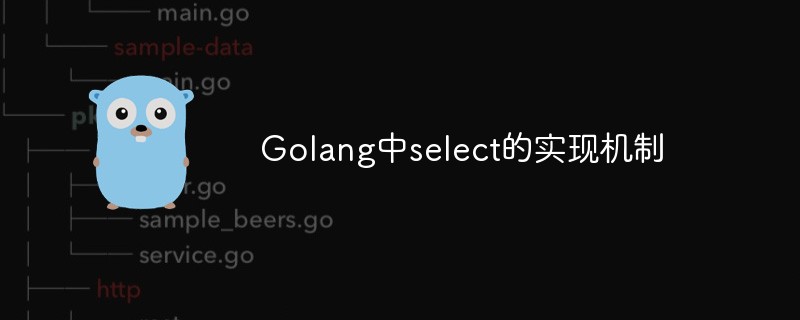
The following column golang tutorial will give you a detailed explanation of the implementation mechanism of select in Golang. I hope it will be helpful to friends in need!

func main(){
var count int
for {
select {
case <-time.Tick(time.Millisecond * 500):
fmt.Println("咖啡色的羊驼")
count++
fmt.Println("count--->" , count)
case <-time.Tick(time.Millisecond * 499) :
fmt.Println(time.Now().Unix())
count++
fmt.Println("count--->" , count)
}
}
}func main(){
t1 := time.Tick(time.Second)
t2 := time.Tick(time.Second)
var count int
for {
select {
case <-t1:
fmt.Println("咖啡色的羊驼")
count++
fmt.Println("count--->" , count)
case <-t2 :
fmt.Println(time.Now().Unix())
count++
fmt.Println("count--->" , count)
}
}
}1. The output of the above fragment turn out?
2.How to explain?
Fragment 1:
1535673600 count---> 1 1535673600 count---> 2 1535673601 count---> 3
咖啡色的羊驼 count---> 1 1535673600 count---> 2 咖啡色的羊驼 count---> 3 1535673601 count---> 4
So why only 1 appears in the first one?
In order to solve this problem, we have to revise the implementation mechanism of select, so we have this article.
1.select case is used to block the listening goroutine. If there is no case, just a select{} , it is to monitor the goroutine in the current program. At this time, please note that there needs to be a real goroutine running, otherwise select{} will report panic
func selectgo(sel *hselect) int {
// ...
// case洗牌
pollslice := slice{unsafe.Pointer(sel.pollorder), int(sel.ncase), int(sel.ncase)}
pollorder := *(*[]uint16)(unsafe.Pointer(&pollslice))
for i := 1; i < int(sel.ncase); i++ {
//....
}
// 给case排序
lockslice := slice{unsafe.Pointer(sel.lockorder), int(sel.ncase), int(sel.ncase)}
lockorder := *(*[]uint16)(unsafe.Pointer(&lockslice))
for i := 0; i < int(sel.ncase); i++ {
// ...
}
for i := int(sel.ncase) - 1; i >= 0; i-- {
// ...
}
// 加锁该select中所有的channel
sellock(scases, lockorder)
// 进入loop
loop:
// ...
// pass 1 - look for something already waiting
// 按顺序遍历case来寻找可执行的case
for i := 0; i < int(sel.ncase); i++ {
//...
switch cas.kind {
case caseNil:
continue
case caseRecv:
// ... goto xxx
case caseSend:
// ... goto xxx
case caseDefault:
dfli = casi
dfl = cas
}
}
// 没有找到可以执行的case,但有default条件,这个if里就会直接退出了。
if dfl != nil {
// ...
}
// ...
// pass 2 - enqueue on all chans
// chan入等待队列
for _, casei := range lockorder {
// ...
switch cas.kind {
case caseRecv:
c.recvq.enqueue(sg)
case caseSend:
c.sendq.enqueue(sg)
}
}
// wait for someone to wake us up
// 等待被唤起,同时解锁channel(selparkcommit这里实现的)
gp.param = nil
gopark(selparkcommit, nil, "select", traceEvGoBlockSelect, 1)
// 突然有故事发生,被唤醒,再次该select下全部channel加锁
sellock(scases, lockorder)
// pass 3 - dequeue from unsuccessful chans
// 本轮最后一次循环操作,获取可执行case,其余全部出队列丢弃
casi = -1
cas = nil
sglist = gp.waiting
// Clear all elem before unlinking from gp.waiting.
for sg1 := gp.waiting; sg1 != nil; sg1 = sg1.waitlink {
sg1.isSelect = false
sg1.elem = nil
sg1.c = nil
}
gp.waiting = nil
for _, casei := range lockorder {
// ...
if sg == sglist {
// sg has already been dequeued by the G that woke us up.
casi = int(casei)
cas = k
} else {
c = k.c
if k.kind == caseSend {
c.sendq.dequeueSudoG(sglist)
} else {
c.recvq.dequeueSudoG(sglist)
}
}
// ...
}
// 没有的话,再走一次loop
if cas == nil {
goto loop
}
// ...
bufrecv:
// can receive from buffer
bufsend:
// ...
recv:
// ...
rclose:
// ...
send:
// ...
retc:
// ...
sclose:
// send on closed channel
}
The channels corresponding to the cases that will not be executed in this selection will give the current goroutine of the team. Regardless of them, is lost. Since time.Tick is created on-site in the case, rather than in the global stack like fragment 2, every time any one is executed, the other one is abandoned. , when you select it again, you need to get it again, and it is new and you need to start over.
This is my current understanding. If you have a better understanding, please leave me a message. Thank you.The above is the detailed content of The implementation mechanism of select in Golang. For more information, please follow other related articles on the PHP Chinese website!
 How to define variables in golang
How to define variables in golang
 What are the data conversion methods in golang?
What are the data conversion methods in golang?
 What are the commonly used libraries in golang?
What are the commonly used libraries in golang?
 What is the difference between golang and python
What is the difference between golang and python
 How to align text boxes in html
How to align text boxes in html
 linux view network card
linux view network card
 What folder is appdata that can be deleted?
What folder is appdata that can be deleted?
 The difference between heap and stack
The difference between heap and stack




